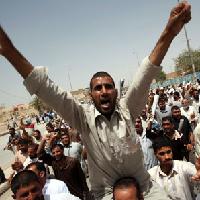
“Democratic” government increases repression
On the second Friday of protests in Iraq, the “Day of Rage” 4 March, government forces used water cannons in Basra and there was a heavy security presence in Baghdad. Again, the lack of jobs and services such as electricity and water, as well as corruption, were in the focus of the protesters.
This “Day of Rage” was named after and inspired by the mass protests in Egypt and Yemen. 2,000 attended the main demonstration Baghdad, where the government tried to limit participation through a vehicle ban and a high number of checkpoints. People on their way to the protest were not allowed to pass. "Our country is lost and, for the last eight years, the government has failed to offer services for people. Thousands of youths are without jobs," protester Bahjat Talib told AP news agency. Government security forces also numbered in the thousands, but the demonstrators, as in Cairo and elsewhere, had their own security checks in place.
In Baghdad, protests were held in different parts of the city. Demonstrators were reported as saying that al-Maliki had become a new Saddam Hussein. Thousands of supporters of Muqtada al-Sadr marched in Sadr city in support of the people of Libya. Al-Sadr is definitely trying to distance himself from the government of Al-Maliki, while not yet formally leaving the coalition with the latter.
Vehicles were banned in more than ten cities, showing the spread of the movement as well as the fear of the government. Demonstrators were accused of being supporters of al-Qaeda or Saddam Hussein. Under this supposedly democratic government, 18 people were killed during the protests the previous Friday, 25 February. Many more were detained or beaten by security forces. The Washington Post reported: “In Baghdad, Hadi al-Mahdi was among four journalists picked up by security forces at a restaurant on Friday and driven to the headquarters of the Iraqi army’s 11th Division. After he was beaten, given electric shocks and threatened with rape, he was taken to a relatively luxurious office, he said. There, he realised from signs and from his own questions that he was in the care of an army intelligence unit. As he waited to be released, Mahdi was asked to sign a statement saying that he had not been tortured. On the way out, he said he saw a room filled with hundreds of detainees wearing hoods.”
The protests are everywhere, in both Shia and Sunni cities. In Basra, 1,000 demonstrated outside the regional council building. “Some protesters carried a piece of wood that was carved in the shape of Iraq. A medical tube was attached to the wood, symbolizing that Iraq as a weak body”, Reuters reported. Protests in Basra forced the governor to resign. In Fallujah, the entire council resigned after the mayor’s office was burned down.
Demonstrations were also held in Mosul in the north, with 3,000 on the main square. However, strong police threats, including shooting in the air, forced the protest to disperse. Other cities involved were Tikrit, Nasiriyah, Amarah, Nassiriya, Garma and Faw, as well as Kirkuk. In Sulaymaniyah, in Iraqi Kurdistan, were this protest wave first started, daily protests are continuing.
The movement in Iraq and Kurdistan need to learn the lessons from Egypt, Tunisia and elsewhere in the region. Key elements of these lessons are: the need to form democratic committees and spread the struggle. In Egypt, the working class was decisive in forcing Mubarak to resign. Also, the struggle is not about replacing Al-Maliki in Baghdad or Barzani in Irbil with other corrupt politicians. The fighting masses need their own organisations and leaders, armed with socialist policies. In Iraq, for the oil wealth to be used for needs of the masses is a key demand.
Special financial appeal to all readers of socialistworld.net |
Support building alternative socialist media Socialistworld.net provides a unique analysis and perspective of world events. Socialistworld.net also plays a crucial role in building the struggle for socialism across all continents. Capitalism has failed! Assist us to build the fight-back and prepare for the stormy period of class struggles ahead. Please make a donation to help us reach more readers and to widen our socialist campaigning work across the world. |
Donate via Paypal |
| M | T | W | T | F | S | S |
|---|---|---|---|---|---|---|
| 1 | 2 | 3 | 4 | 5 | 6 | |
| 7 | 8 | 9 | 10 | 11 | 12 | 13 |
| 14 | 15 | 16 | 17 | 18 | 19 | 20 |
| 21 | 22 | 23 | 24 | 25 | 26 | 27 |
| 28 | 29 | 30 | 31 | |||


Be the first to comment